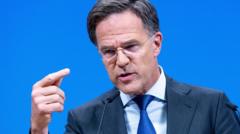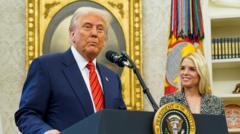In a strategic move prior to the upcoming NATO summit, Secretary General Mark Rutte has proposed that NATO allies collectively increase their defense spending to 5% of GDP, a response to former President Trump’s demands. This marks a shift from the existing 2% benchmark and aims at ensuring accountability among member states while addressing security concerns.**
NATO's Ambitious Defense Spending Proposal Aims to Please Trump Ahead of Crucial Summit**

NATO's Ambitious Defense Spending Proposal Aims to Please Trump Ahead of Crucial Summit**
NATO Secretary General Mark Rutte proposes a significant increase in defense spending among member states to meet President Trump's expectations and avoid past criticisms.**
NATO Secretary General Mark Rutte is making headlines with a bold proposition just ahead of the upcoming NATO summit. In efforts to avoid the critical stance from former President Donald Trump, who previously condemned European allies for insufficient defense expenditures, Rutte has suggested a plan to increase NATO nations’ defense spending to 5% of their gross domestic product (GDP).
This proposed target represents a significant leap from the current NATO benchmark of 2% of GDP. The move is seen as an attempt to not only address Trump's transactional approach to relationships but to fortify defenses particularly against concerns surrounding Russia’s military expansion. Many European nations are wary of this hefty commitment, prompting questions about whether this endeavor aims to deter aggressors or cater to political pressures.
In a recent press conference held in Brussels, Rutte outlined a compromise that could ease some of the financial burden by requiring core defense spending to reach 3.5% of GDP, while allowing for the remaining 1.5% to be classified as "defense-related expenditure." This term is notably broad, giving countries leeway in how they account for these costs, which can incorporate infrastructure improvements and industry investments.
Rutte has also indicated that the U.S. would subscribe to this new spending ceiling. However, given that Washington is currently investing around 3.4% in defense, the step-up would be negligible for them compared to the challenge it poses for European allies. While there is no clear timeline for reaching these targets, expectations suggest a decade-long framework, though without firm sanctions for noncompliance.
To maintain accountability, Rutte proposed that NATO nations outline yearly plans to demonstrate their gradual progress toward achieving the new goal, steering clear of sudden spending surges towards deadlines. As part of this initiative, Rutte will soon meet with UK Prime Minister Sir Keir Starmer, particularly noteworthy as the UK has set a less ambitious defense spending goal of 2.5% of GDP by 2027, with a potential increase to 3% thereafter.
Meanwhile, U.S. Defense Secretary Pete Hegseth expressed confidence in the commitment from many NATO countries and suggested that nations such as France, Germany, and Poland are on board with Rutte's 5% pledge, assuring reporters that full compliance is achievable and crucial for collective security.
As discussions continue, one thing remains certain: the pressure is on for NATO nations to step up their commitments to defense spending, reflecting not only a strategic necessity but also the intricate balance of international diplomacy shaped by evolving global threats.




















